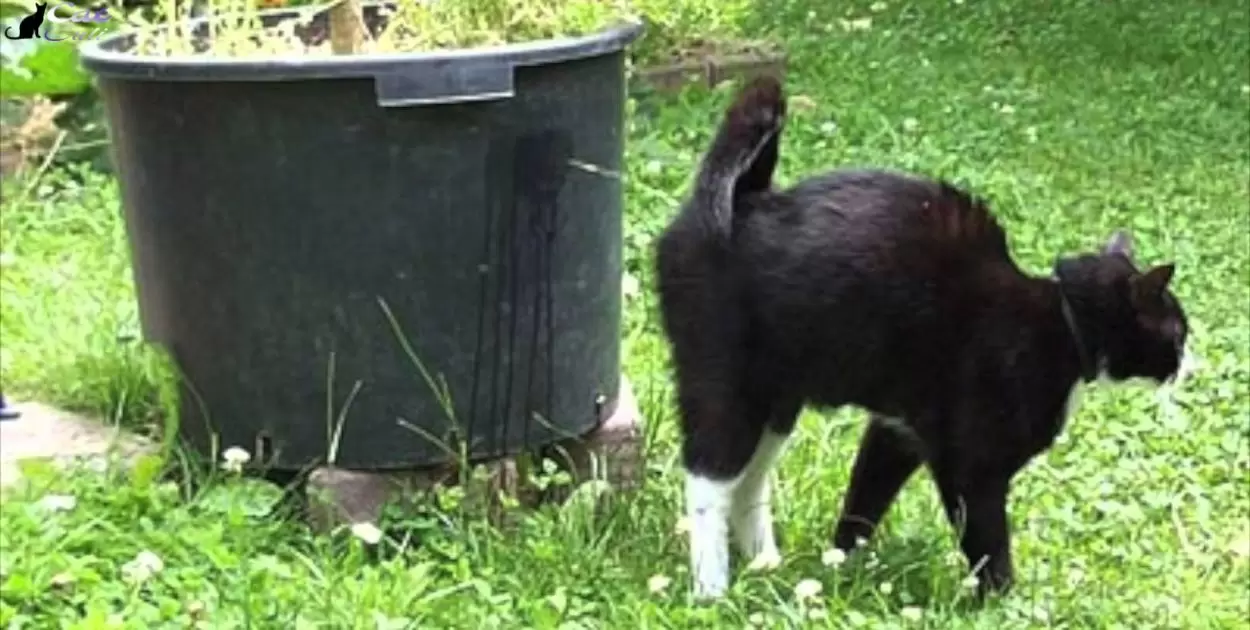When a cat’s pee is foamy, it might indicate potential health issues. Various factors, such as diet, hydration, and stress, can contribute to foamy urine. It could also be a sign of urinary tract infections or kidney problems. If you notice persistent foamy urine, consulting a veterinarian is essential for proper diagnosis and treatment.
Curiosity piqued? Ever wondered, Why is my cat’s pee foamy? Unravelling the mystery behind your feline friend’s unusual urinary habits can be both intriguing and crucial for their well-being. From diet and hydration to potential health concerns, understanding the reasons behind foamy urine is like unlocking a secret code to your cat’s health.
Stay with us as we uncover the mystery behind Why Is My Cat’s Pee Foamy? Understanding the reasons behind foamy urine in cats is not only fascinating but crucial for their well-being. From diet to potential health concerns, we’ll explore the various factors contributing to this peculiar behaviour.
Possible Causes Of Foamy Urine
Foamy cat urine can result from various factors. Dietary issues, such as excessive protein intake, may contribute to this phenomenon. Dehydration can lead to foamy urine, emphasizing the importance of maintaining your cat’s hydration levels. If you notice foamy urine persisting, consider consulting a vet to explore potential health concerns.
Stress is another factor linked to foamy urine in cats. Changes in the environment, new pets, or disruptions to their routine can induce stress, manifesting in foamy pee. Observing your cat’s behaviour and addressing possible stressors can be key to resolving the issue and ensuring your feline companion’s well-being.
Understanding Feline Urinary Foam Issues
Feline urinary foam issues arise when a cat’s pee appears bubbly, indicating potential health concerns. Various factors, such as diet, hydration, and stress, contribute to this phenomenon. If you notice foamy urine, it’s essential to comprehend these aspects for the well-being of your furry friend.
Observing behavioural changes is crucial in understanding feline urinary foam issues. Cats may display signs of discomfort or altered habits during this time. Regular vet check-ups and a keen eye on your cat’s behaviour can aid in early detection and effective management of any underlying causes related to foamy urine.
Health Concerns Behind Foamy Urine
Foamy urine in cats often signals potential health concerns. Various factors, such as diet, hydration, and stress, contribute to this observable change. If your cat’s pee appears consistently foamy, it may indicate underlying issues like urinary tract infections or kidney problems. Monitoring these signs actively and consulting a vet promptly ensures early detection and appropriate intervention, promoting your cat’s overall health.
To address health concerns related to foamy urine, it’s crucial to be proactive. Regular vet check-ups, a balanced diet, and maintaining a stress-free environment contribute significantly to your cat’s well-being. Understanding the root causes of foamy urine empowers pet owners to take informed actions, fostering a healthier and happier life for their feline companions.
Dietary Factors And Foamy Pee
| Dietary Factors | Potential Impact on Foamy Pee |
| High-Protein Diet | Excessive foamy urine possible |
| Dietary Allergies | Can contribute to urinary issues |
| Dehydration | Concentrated urine, potential foam |
| Imbalance of Minerals | May lead to foamy urine |
| Low-Quality Food | Poor nutrition can affect urine |
This table briefly outlines how various dietary factors can potentially influence the occurrence of foamy pee in cats.
Analyzing Stress As A Contributor
Stress plays a significant role in a cat’s urinary habits, contributing to foamy pee. When felines experience stress, it can lead to changes in their behaviour, including alterations in urination patterns. Identifying and addressing the stressors in your cat’s environment is crucial for promoting a calm and healthy lifestyle.
Factors such as changes in routine, new additions to the household, or even environmental disturbances can trigger stress in cats. By observing your cat’s behaviour and making adjustments to minimize stressors, you can positively impact their overall well-being and potentially reduce the occurrence of foamy urine.
When To Worry About Foamy Urination

Concerned about your cat’s foamy urination? Don’t wait – if you notice persistent foamy pee, it’s time to take action. Foamy urine might signal underlying health issues such as infections or kidney problems.
Schedule a vet visit promptly to ensure your cat receives the necessary care and attention. Observation is key; any sudden change in your cat’s urination habits should be addressed promptly.
Early detection and intervention can make a significant difference in managing and treating potential health issues. Keep a close eye on your furry friend, and if foamy urination becomes a consistent issue, consult your veterinarian for personalized guidance and peace of mind.
Effects Of Dehydration On Cat’s Pee
Dehydration can impact a cat’s urine, making it more concentrated and potentially darker in color. When a cat doesn’t consume enough water, its body tries to conserve fluids, leading to a reduced urine output. As a result, the urine may become more concentrated, and in some cases, it could appear foamy.
Monitoring your cat’s water intake and ensuring they have access to fresh water can help prevent dehydration and maintain proper urinary health. In addition to concentrated urine, dehydration may contribute to urinary tract issues in cats.
Connection Between Infections And Foam
Infections in cats can lead to foamy urine, revealing a direct connection between their health and urinary habits. When felines suffer from urinary tract infections, the irritation can cause urine to become frothy. Recognizing these signs promptly enables pet owners to seek timely veterinary care, ensuring their cat’s well-being.
Maintaining awareness of the link between infections and foamy urine empowers cat owners to take proactive measures. Regular check-ups and a keen eye on changes in urinary behaviour can help detect infections early on. By addressing these health issues swiftly, owners can contribute to their cat’s overall health and happiness.
Foamy Pee And Feline Hydration Levels
- Dehydration Risks: Cats with insufficient water intake may experience urinary issues and foamy urine.
- Wet Food Consideration: Wet cat food can contribute to hydration, reducing the likelihood of foamy pee.
- Monitor Water Bowl: Regularly check the water bowl to ensure it is clean and filled to encourage drinking.
- Veterinary Consultation: If foamy urine persists, consult a vet to rule out underlying health concerns.
- Promote Hydration: Introduce ways to encourage your cat to drink more water for optimal hydration.
- Healthier Urinary Function: Proper hydration supports overall urinary health and minimizes foamy pee risks.
Exploring Behavioural Triggers For Foamy Urine
When it comes to foamy urine in cats, understanding behavioural triggers is key. Stress and anxiety can play a significant role in causing your cat’s pee to become foamy. Changes in the environment, new additions to the household, or even alterations in their routine can contribute to this behavioural response.
Creating a calm and comfortable space for your cat, along with maintaining a consistent routine, can help alleviate stress-related foamy urine. Regular playtime and positive interactions can go a long way in reducing behavioural triggers and promoting a healthier urinary environment for your feline companion.
Signs Of Kidney Issues In Cats
Cats with kidney issues exhibit noticeable signs. Increased thirst and frequent urination are common indicators. A decrease in appetite and weight loss may signal kidney problems. If you observe these signs, promptly consulting a veterinarian is crucial for early detection and effective management of feline kidney issues.
Keep an eye on your cat’s behaviour. If they start drinking more water than usual or seem less interested in food, it could be a red flag for kidney concerns. Regular veterinary check-ups help catch these signs early, ensuring timely intervention for your cat’s well-being.
Dietary Allergies And Foamy Urine
If your cat’s pee appears foamy, it might be linked to dietary allergies. Cats, like humans, can be sensitive to certain foods, and this sensitivity can manifest in various ways, including changes in urine consistency. Pay attention to recent changes in your cat’s diet, as introducing new ingredients could be a potential trigger for foamy urine.
To address this concern, consult your veterinarian to identify potential allergens and adjust your cat’s diet accordingly. By being proactive about dietary choices, you can help alleviate foamy urine issues related to allergies, ensuring your feline companion maintains optimal health and well-being.
Foamy Pee As An Indicator
Curious about your cat’s foamy pee? It’s not just a random occurrence; foamy urine can signal various health indicators in your feline friend. Dietary factors, hydration levels, and potential infections all play a role in this unusual behaviour. Monitoring and understanding these signs can help you take proactive steps to ensure your cat’s well-being.
If you notice persistent foamy pee, consider consulting a veterinarian for a thorough examination. They can pinpoint the specific issue and recommend appropriate steps to address it. Being attentive to these indicators and seeking timely veterinary advice can contribute significantly to maintaining your cat’s overall health and happiness.
Role Of Hormonal Changes In Foam
Hormonal changes play a vital role in causing foamy urine in cats. When hormonal fluctuations occur, it can affect the composition of urine, leading to foaming. Keep an eye on your cat’s behaviour and any signs of hormonal imbalances, as these changes can impact not only urinary patterns but also overall health.
Understanding the role of hormones in foamy urine helps cat owners be proactive in managing their pet’s well-being. Regular veterinary check-ups can identify hormonal issues early on, allowing for timely intervention and ensuring a happy and healthy life for your furry companion.
Preventing And Managing Foamy Urination

Discovering ways to prevent and manage foamy urination in your cat is essential for their overall health. Start by ensuring your cat stays well-hydrated; dehydration can contribute to urinary issues. Maintain a balanced diet to address potential dietary factors linked to foamy pee.
Regular check-ups with your veterinarian help catch any underlying health concerns early on, allowing for effective prevention and management strategies.Creating a stress-free environment at home can also play a crucial role in preventing foamy urination. Cats are sensitive creatures, and a calm atmosphere can positively impact their urinary health.
If you observe any behavioural changes or persistent foamy urine, consult your vet promptly for personalized advice. With proactive measures and attentive care, you can actively prevent and manage foamy urination, ensuring your cat leads a happy and healthy life.Understanding Cat Utis And Foam
If your cat’s urine is foamy, it could be a sign of a urinary tract infection (UTI). Cats, like humans, can develop UTIs, causing discomfort and changes in urinary habits. Identifying and addressing UTIs promptly is crucial for your cat’s health.
Keep an eye on other symptoms, such as increased frequency of urination or straining, and consult your veterinarian to ensure your feline friend receives the necessary care.
Foamy urine in cats may signal an infection affecting their urinary system. In addition to observing changes in urination, be attentive to any signs of discomfort or lethargy. Timely intervention and proper treatment can help alleviate your cat’s discomfort and prevent potential complications associated with urinary tract infections.
Foamy Urine And Potential Diagnoses
If your cat’s urine is consistently foamy, it may signal potential health issues. Various factors, including diet, hydration levels, and stress, can contribute to this unusual behaviour. It’s crucial to observe your cat’s habits and consult with a veterinarian for a thorough examination to identify and address any underlying diagnoses.
Foamy urine in cats might indicate urinary tract infections, kidney problems, or dietary allergies. Regular veterinary check-ups, along with a keen eye on your cat’s behaviour, can help in early detection and prompt intervention. Taking proactive steps ensures the well-being of your feline companion and helps maintain their urinary health.
Hygiene Factors Affecting Urinary Foam
Maintaining cleanliness is key in understanding hygiene factors affecting urinary foam in cats. A dirty litter box, for instance, may lead to stress and discomfort, triggering foamy urine. Regular cleaning routines and providing a clean, inviting bathroom space can positively impact your cat’s urinary habits.
Ensuring your cat’s water bowl is consistently clean and filled can play a significant role. Dehydration, often linked to insufficient water intake, might contribute to foamy pee. By addressing hygiene aspects in your cat’s environment, you contribute to their overall well-being and potentially minimize instances of foamy urine.
FAQ’s
How do you treat foamy urine in cats?
Provide clean water, adjust diet, and seek vet guidance for underlying issues.
Is foamy cat pee normal?
Occasional foaming is normal, but persistent foamy urine may signal health concerns.
Why is there white stuff in my cat’s pee?
White sediment can indicate urinary issues; consult a vet for proper diagnosis and care.
What are the symptoms of foamy virus in cats?
No specific “foamy virus”; consult a vet if you observe abnormal urine, lethargy, or appetite changes.
Conclusion
In conclusion, understanding Why Is My Cat’s Pee Foamy? is vital for feline health. By recognizing potential triggers like diet, hydration, and stress, pet owners can take proactive steps to ensure their cats’ well-being.
Regular veterinary check-ups and a clean, stress-free environment contribute to a happy, foam-free urinary experience for your feline companion. Stay vigilant, stay informed, and provide the care your cat needs to keep those litter box mysteries at bay. Your cat’s health and comfort depend on it.








